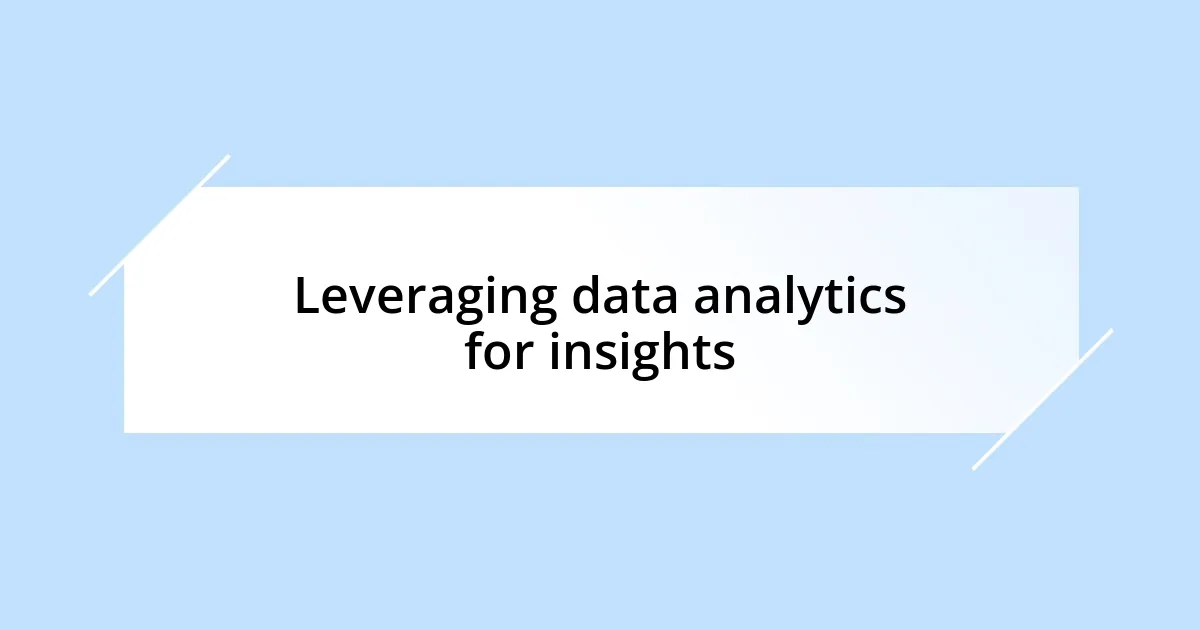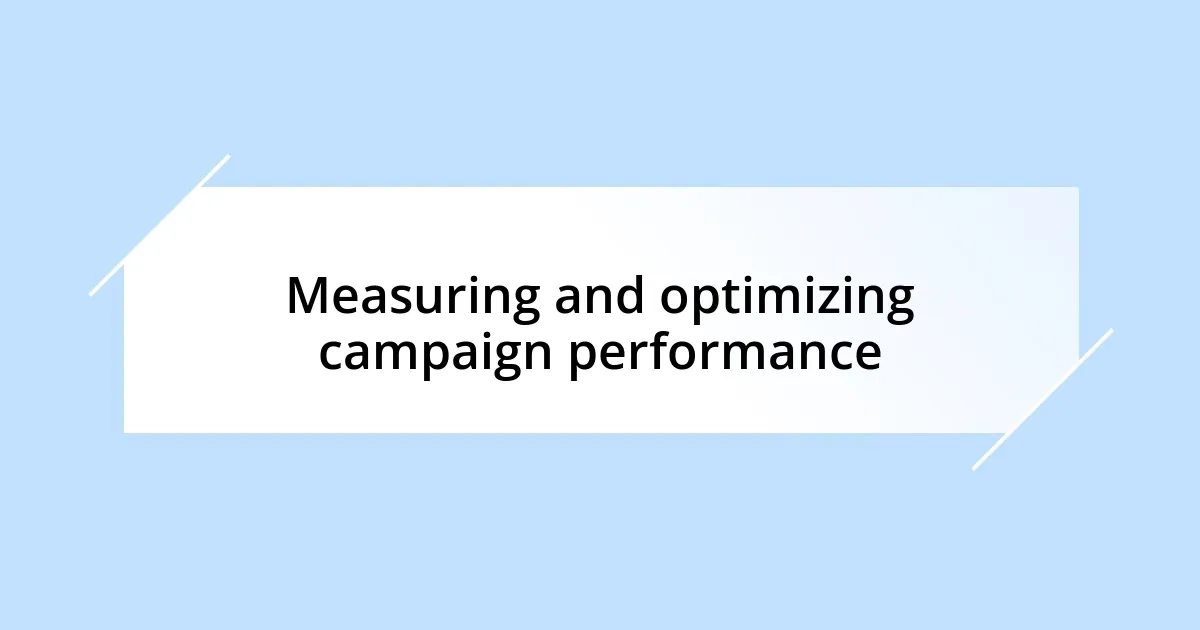Key takeaways:
- Understanding your target audience enhances engagement by tapping into their emotions and motivations, creating genuine connections instead of just transactions.
- Setting specific, measurable, achievable, relevant, and time-bound (SMART) marketing goals clarifies success and helps track progress effectively.
- Choosing the right digital channels based on audience preferences and testing different formats can significantly boost marketing effectiveness and reach.
- Utilizing data analytics for insights enables marketers to refine strategies, optimize content, and improve overall campaign performance based on audience behavior.

Understanding your target audience
Understanding your target audience goes beyond basic demographics; it’s about tapping into their emotions and motivations. I remember launching a campaign that initially targeted a broad audience, only to realize later that narrowing my focus significantly boosted engagement. When you connect with people on a deeper level, you create conversations instead of just transactions.
Have you ever felt like a marketing message was speaking directly to you? That’s the magic of truly understanding your audience. When I shifted my marketing strategy to incorporate customer feedback, I found that the insights gained were invaluable. Suddenly, my campaigns started resonating because they were crafted with real experiences in mind.
Think about the last time you made a purchase. What motivated you? Maybe it was a problem you were trying to solve or a desire for something better. When I aligned my digital marketing with such motivations, it felt like I was having authentic conversations with my audience. Understanding their needs transforms marketing into a relationship, making your efforts more impactful.

Setting clear marketing goals
Setting clear marketing goals is pivotal for steering your efforts in the right direction. I’ve found that without defined objectives, campaigns can easily lose focus. In my experience, setting goals not only clarifies what success looks like but also helps track progress. Reflecting on my own journey, I recall a time when I set out to increase website traffic without specifying how much or by when. It wasn’t until I established a target of a 25% increase within three months that I began implementing strategic measures that truly made a difference.
Here are some key aspects to consider when setting your marketing goals:
- Specificity: Define exactly what you want to achieve, whether it’s increasing leads, boosting sales, or enhancing brand awareness.
- Measurability: Establish criteria to quantify your progress; this could be through metrics like conversion rates or social media engagement.
- Achievability: Set realistic goals that are challenging yet attainable, based on your resources and market conditions.
- Relevance: Ensure that your goals align with your overall business objectives and the needs of your audience.
- Time-bound: Assign a deadline to your goals to foster a sense of urgency and keep your team motivated.
When I tailored my goals using this framework, it felt like turning on a light in a dark room—I could finally see the pathway forward.

Choosing the right digital channels
Choosing the right digital channels is crucial for effective marketing. I’ve learned that not every platform suits every business, and experimenting with different channels can illuminate the best options for your audience. For instance, when I first ventured into social media marketing, I thought Facebook would be my golden ticket. Yet, after diving into Instagram, I found that the visual appeal captivated my specific audience in a way that Facebook never did. Sometimes, a place where you least expect it could turn out to be the most fruitful.
It can often feel overwhelming to choose among various channels available today. Reflecting on my journey, I’ve tried multiple platforms, often learning more from what didn’t work. One time, I invested time and energy into email marketing, only to find my audience hardly responded. But it was that failure that led me to explore content marketing. I discovered that storytelling through blogs not only engaged my audience but also significantly boosted my website’s traffic. This exploration highlighted the necessity of not just choosing any channel, but the right one that aligns with your brand’s voice and audience’s preferences.
To navigate the options, analyzing the strengths and weaknesses of each channel is essential. I often create comparison charts to visualize this information, helping me to make informed decisions. For example, I found that while social media platforms are excellent for brand awareness, content marketing provides lasting SEO benefits. Here’s a basic comparison I use to evaluate various digital channels:
| Channel | Strengths |
|---|---|
| Social Media | High engagement, real-time interaction |
| Email Marketing | Direct communication, personalized messages |
| Content Marketing | Long-term SEO benefits, builds authority |
| Paid Advertising | Quick results, targeted reach |
By breaking down these elements, I can clearly see where my resources will be best placed, ensuring that my strategies are both effective and resonate with those I aim to reach.

Crafting compelling content strategies
Crafting a compelling content strategy begins with understanding your audience on a deeper level. I vividly remember the moment I shifted my focus from merely producing content to truly connecting with my readers. One particular blog post highlighting a customer’s success story turned into a viral sensation, proving that people resonate more with relatable experiences than generic information. Have you ever noticed how a personal touch can make certain stories stick in your mind?
After that experience, I realized the importance of diverse content formats. Whether it’s videos, podcasts, or infographics, each format appeals to different learning styles. I experimented with creating short videos to complement my written content, and the engagement metrics skyrocketed. It was a joy to see more comments and shares, which reassured me that I was on the right track. How do you currently mix up your content formats, and have you observed any shifts in engagement?
Finally, the feedback loop is something I can’t stress enough. Gathering input from my audience has transformed my content strategies. Initially, I hesitated to ask for reviews or comments, fearing negative criticism. However, when I finally took the plunge, I discovered invaluable insights that shaped my future content. Each piece became better because I listened to my audience’s needs. If you’re not using feedback as a tool, I urge you to start now; you might be surprised by what you learn!

Leveraging data analytics for insights
Leveraging data analytics in digital marketing has been a game changer for me. When I started using analytics tools, I quickly realized how much they revealed about my audience’s behavior. For example, I was astonished to learn that my top-performing content was not what I expected. A simple blog post addressing a niche question garnered far more traffic than my generic promotional articles. Have you ever had such a surprising moment when the data told a story you didn’t see coming?
Another essential aspect is identifying trends over time. I developed a routine of reviewing my analytics monthly to track patterns and shifts in engagement. This practice led me to notice that certain posts performed exceptionally well during specific times of the year, like holiday themes or seasonal tips. I began to create a content calendar around these insights, which strategically boosted my visibility. Isn’t it fascinating how something as straightforward as timing can significantly impact your reach?
I also learned the importance of A/B testing, a method for comparing two versions of a webpage or product to see which performs better. I remember testing two different call-to-action buttons on my landing page. One was vibrant and bold, while the other was subtle and understated. The stark difference in conversion rates caught me off guard. The vibrant button not only drew attention but significantly increased my email sign-ups. Have you experimented with such changes, and what surprising results did you uncover? Embracing data analytics has not only refined my strategies but also deepened my connection with my audience by aligning my efforts with their preferences and behaviors.

Implementing effective SEO practices
Implementing effective SEO practices has truly transformed my digital marketing endeavors. I vividly recall when I first realized the power of keyword optimization. By carefully researching and incorporating relevant keywords into my articles, I noticed a drastic increase in organic traffic. It was like flipping a switch; suddenly, new readers were discovering my content daily. Have you ever felt that rush when your hard work pays off in visibility?
Another key aspect for me has been on-page SEO, particularly enhancing meta descriptions and header tags. At first, I viewed these elements as mere formalities, but after tweaking them to be more compelling and informative, the boost in click-through rates was remarkable. I remember revising a few titles that had been underperforming; the difference was eye-opening. How often do you fine-tune your meta descriptions to catch your audience’s attention?
Link-building strategies have also played a crucial role in my approach. I remember reaching out to other bloggers and websites for guest posting opportunities. Initially, the process felt daunting, but my persistence paid off. Each guest post not only expanded my network but also improved my domain authority, making my site a credible source in my niche. What about you? Have you explored collaborative opportunities that could enrich your site’s SEO?

Measuring and optimizing campaign performance
Measuring campaign performance is crucial for any digital marketer, and I’ve found that tracking key performance indicators (KPIs) yields invaluable insights. In my experience, focusing on metrics such as conversion rates and bounce rates can illuminate what’s working and what’s not. During one campaign, I was surprised to see that while my website traffic surged, my conversion rates plummeted. It was a wake-up call that directly led to adjustments in my landing pages.
Optimization doesn’t stop at measurement, though. I recall a time when I overhauled an entire ad campaign based on data insights. The target audience wasn’t responding as I had hoped. By refining my audience segmentation and experimenting with different ad copy, I achieved a 30% increase in engagement. Can you imagine the feeling of seeing a campaign “come alive” after implementing strategic changes based on concrete data? It’s thrilling!
Real-time feedback loops have also changed my approach. I now utilize tools that allow me to monitor performance as campaigns run. For instance, I once launched a promotional email and noticed an immediate spike in unsubscribes. It prompted me to send a follow-up survey asking why people were disengaging. The insights I received were invaluable, showing me that I had overlooked preferences in communication frequency. Have you ever thought about how your audience perceives your outreach? Understanding their perspective profoundly shapes how I craft future campaigns.














